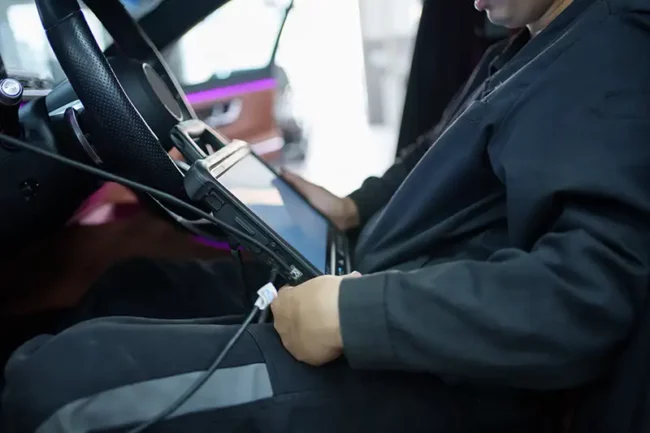Houston ADAS Calibration for New Windshield Installation
 Your vehicle’s windshield is actually a critical component of your safety system. Modern windshields are designed to withstand significant impact, helping to maintain the structural integrity of your car, especially during a rollover. In the event of a collision, your windshield plays a vital role in supporting the roof and preventing it from collapsing.
Your vehicle’s windshield is actually a critical component of your safety system. Modern windshields are designed to withstand significant impact, helping to maintain the structural integrity of your car, especially during a rollover. In the event of a collision, your windshield plays a vital role in supporting the roof and preventing it from collapsing.
In addition, your Advanced Driver Assistance Systems (ADAS) are sophisticated systems that rely on sensors and cameras often integrated with or mounted behind your windshield. For ADAS to function accurately, these sensors require a clear, unobstructed view of the road. Even minor windshield damage or misalignment can impair their ability to “see” correctly, leading to inaccurate readings or system failures. Ensuring proper ADAS calibration after new windshield installation in Houston is essential for these features to operate properly and keep you safe on the road.
How ADAS Systems Work
ADAS are a suite of technologies that enhance vehicle safety and driver convenience. They use a network of sensors in your vehicle, including cameras, radar, and lidar, to perceive your vehicle’s surroundings in real-time. This data is then processed by onboard computers running complex algorithms to identify potential hazards, monitor your driving behavior, and assist with various driving tasks.
Cameras are often mounted behind the windshield. These provide visual information about lane markings, traffic signs, pedestrians, and other vehicles. Radar sensors use radio waves to measure the distance and speed of objects on and alongside the road. Lidar employs laser beams to create a detailed 3D map of the environment. Some systems also incorporate ultrasonic sensors for parking assistance.
The information gathered by these sensors is fused together to create a comprehensive understanding of the driving scenario you happen to be in at any given moment. Based on this information, your ADAS can provide warnings via instant alerts. More advanced systems can even take active control of the vehicle, such as initiating emergency braking, adjusting steering to stay within lanes, or adapting the vehicle’s speed to maintain a safe following distance.
Which ADAS Systems are In Your Vehicle?
It’s difficult to definitively say which specific ADAS features are in your vehicle without knowing the exact year and trim level. However, here is a general overview of the ADAS features that are often found in newer models:
Tesla ADAS
Tesla’s ADAS suite is known as Autopilot, with an optional upgrade to Full Self-Driving (Supervised). Tesla primarily relies on its camera-based “Tesla Vision” system for its Autopilot function in your car. Standard Autopilot typically includes:
- Traffic-Aware Cruise Control: Maintains a set speed and distance from the vehicle ahead.
- Autosteer: Assists with steering within clearly marked lanes.
Enhanced Autopilot and Full Self-Driving (Supervised) add more advanced features like:
- Navigate on Autopilot: Actively guides the car on the highway from on-ramp to off-ramp, including lane changes and navigating interchanges.
- Auto Lane Change: Assists in moving to an adjacent lane on the highway.
- Autopark: Helps automatically parallel or perpendicular park.
- Summon/Smart Summon: Allows you to move your car in and out of tight spaces using the mobile app.
- Traffic Light and Stop Sign Control: Identifies and reacts to traffic signals.
- Autosteer on City Streets: Assists with steering on city streets (part of FSD).
Mercedes ADAS
Mercedes’ ADAS features are often branded under the term Mercedes-Benz Driver Assistance Systems. These systems usually include:
- Active Brake Assist: Can automatically apply the brakes to prevent or mitigate collisions.
- ATTENTION ASSIST®: Monitors driver drowsiness and provides alerts.
- Active Lane Keeping Assist: Helps keep the vehicle within its lane by providing steering corrections.
- Adaptive Highbeam Assist: Automatically adjusts high beam usage based on traffic conditions.
- DISTRONIC PLUS® with Steering Assist: Combines adaptive cruise control with active steering assistance, especially helpful in traffic.
- Blind Spot Assist: Alerts the driver to vehicles in their blind spot.
- Rear Cross-Traffic Alert: Warns of approaching traffic when reversing.
BMW ADAS
BMW’s driving assistance systems generally incorporate:
- Forward Collision Warning with Mitigation: Alerts of potential collisions and can apply brakes.
- Lane Departure Warning: Monitors lane markings and warns of unintentional drifting.
- Blind Spot Detection: Alerts to vehicles in adjacent lanes.
- Adaptive Cruise Control: Maintains a set speed and distance, often with a Stop & Go function for traffic.
- Parking Assistant Plus: Uses cameras and sensors for automated parking.
- Lane Keeping Assistant: Provides steering intervention to stay in the lane.
- Active Blind Spot Detection: Can provide steering input to avoid collisions.
- Emergency Stop Assistant: Can initiate a controlled stop if the driver is unresponsive.
Toyota ADAS
Toyota’s ADAS package is known as Toyota Safety Sense (TSS), and the options vary depending on your vehicle’s model and year. Features you may have:
- Pre-Collision System (PCS) with Pedestrian Detection: Helps detect vehicles, pedestrians, or cyclists and can provide warnings and automatic emergency braking.
- Dynamic Radar Cruise Control (DRCC): Adaptive cruise control that maintains a set distance from the vehicle ahead.
- Lane Departure Alert (LDA) with Steering Assist: Warns of lane departures and can provide gentle steering correction.
- Lane Tracing Assist (LTA): When DRCC is active, helps keep the vehicle centered in its lane.
- Road Sign Assist (RSA): Detects and displays traffic signs.
- Automatic High Beams (AHB): Automatically switches between high and low beams.
- Blind Spot Monitor (BSM) with Rear Cross-Traffic Alert (RCTA): Available on many models.
Honda ADAS
Honda’s ADAS technology is called Honda Sensing®. It may incorporate:
- Collision Mitigation Braking System™ (CMBS™): Can apply brake pressure if a collision risk is detected.
- Road Departure Mitigation System (RDM): Adjusts steering and braking if the vehicle drifts out of detected lanes.
- Adaptive Cruise Control (ACC): Maintains a set following interval.
- Lane Keeping Assist System (LKAS): Adjusts steering to help keep the vehicle centered.
- Traffic Sign Recognition (TSR): Can notify drivers of posted speed limits.
- Blind Spot Information System: Alerts to vehicles in adjacent lanes.
- Cross Traffic Monitor: Warns of approaching vehicles when reversing.
ADAS for Dodge/Chevrolet and Other Domestic Manufacturers
Newer domestic vehicles can also offer a range of ADAS features, though the specific names and availability will vary depending on the model and trim. You’ll often find features like:
- Forward Collision Alert/Automatic Emergency Braking
- Lane Departure Warning/Lane Keep Assist
- Blind Spot Monitoring
- Rear Cross-Traffic Alert
- Adaptive Cruise Control
- Parking Assist features
To determine the specific ADAS features in your vehicle, check your owner’s manual first—this is the most reliable source of information for your specific vehicle. You can also look for buttons or settings related to driver assistance. These are often located on the steering wheel, dashboard, or within the infotainment system’s menus. You can also contact your local dealership as they will be able to provide precise information based on your VIN (Vehicle Identification Number).
The Recalibration Process
The recalibration process involves using specialized tools and software by our trained technicians. First comes the static recalibration. The technician will connect diagnostic equipment to your car’s computer, which will give them specific procedures to follow. This might involve positioning targets at precise distances and angles in front of your vehicle. The software adjusts the sensor’s aim and field of view until it meets the system’s required specifications. Next comes dynamic recalibration. This involves driving the vehicle on specific roads under certain conditions, which allows the system to self-learn and adjust. Skipping or improperly performing this recalibration can lead to system malfunctions and ultimately compromise your safety.
Windshield Installation and Recalibration Experts in Houston
If you need windshield replacement along with ADAS recalibration, our certified technicians provide fast, reliable service. Get a free quote today.
